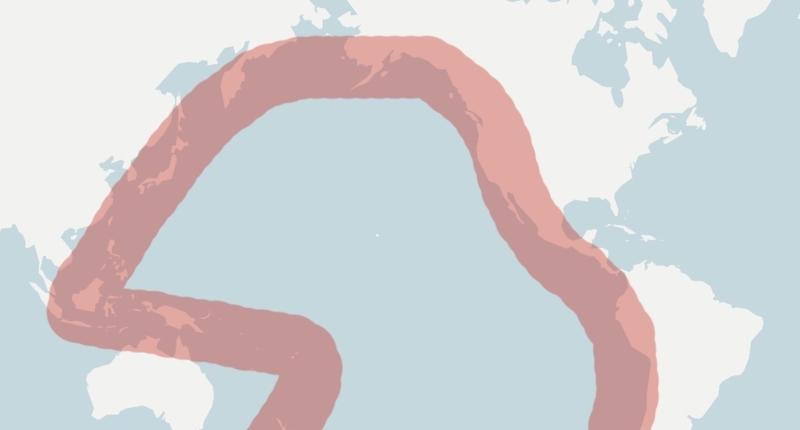The Pacific Ring of Fire is a horseshoe-shaped region that surrounds the Pacific Ocean and is characterized by a high incidence of earthquakes and volcanic activity. The area has no less than 450 active volcanoes and is the location of the most significant seismic activity globally, with nine out of ten earthquakes occurring there. The earthquakes that recently hit Latin America, including Peru and Ecuador, occurred in this region, where seismic activity is prevalent. Plate tectonics are responsible for the existence of the Pacific Ring of Fire, and the movement of plates generates geological activity along their edges. Subduction zones, where one plate slides under the other, are responsible for much of the volcanic activity in this region. In areas close to board boundaries, earthquake risk is high.
The Pacific Ring of Fire and its Relationship to Earthquakes in Latin America
The Pacific Ring of Fire is a large horseshoe-shaped region that extends for 40,000 km around the Pacific Ocean and passes through several countries, including the USA, Canada, Russia, Japan, Southeast Asia, and Oceania. This region is characterized by the presence of numerous active volcanoes and a high incidence of earthquakes. In fact, 9 out of 10 earthquakes recorded in the world occur within this area, and there are no fewer than 450 active volcanoes along the circuit.
Earthquake risk is particularly high in places above or near board boundaries. This is the region of the world with the most significant seismic activity, with seismographs detecting some form of tremor every five minutes, on average. The US Oceanic and Atmospheric Agency (NOAA) attributes the existence of the Pacific Ring of Fire to plate tectonics.
When plates move, they can generate geological activity at their edges, sometimes separating or colliding with each other. Much of the volcanic activity along the Pacific Ring of Fire occurs along subduction zones, where one tectonic plate slides under the other. The enormous pressure exerted by the downward-moving plate on the magma in the Earth’s interior causes it to seek a path to the surface at the plate’s edge, giving birth to volcanoes.
The recent earthquakes in Latin America occurred in the Pacific Ring of Fire region, where seismic activity is prevalent. The strongest tremors were observed in the coastal regions of Peru, with a magnitude of 7.0, and Ecuador, with a magnitude of 6.8. The Peruvian National Seismological Center recorded the earthquake at 12:12 p.m. local time, with its epicenter in Tumbes, in the north of the country. In Ecuador, the earthquake struck the country’s coast at 12:12 p.m. local time, and the epicenter was approximately 30 kilometers from Palau municipality in Guayas province.
In Argentina, the strongest earthquake occurred in Mendoza, with a magnitude of 5.0, while in Chile, it was in Arica, with a magnitude of 4.0. In Mexico, the record was approximately 150 kilometers from San Jose del Cabo, with a magnitude of 4.3.
In conclusion, the Pacific Ring of Fire is a region with a high incidence of earthquakes and volcanic activity due to plate tectonics. Recent earthquakes in Latin America occurred in this region, highlighting the potential dangers associated with living in areas with a high risk of seismic activity.
Don’t miss interesting posts on Famousbio

